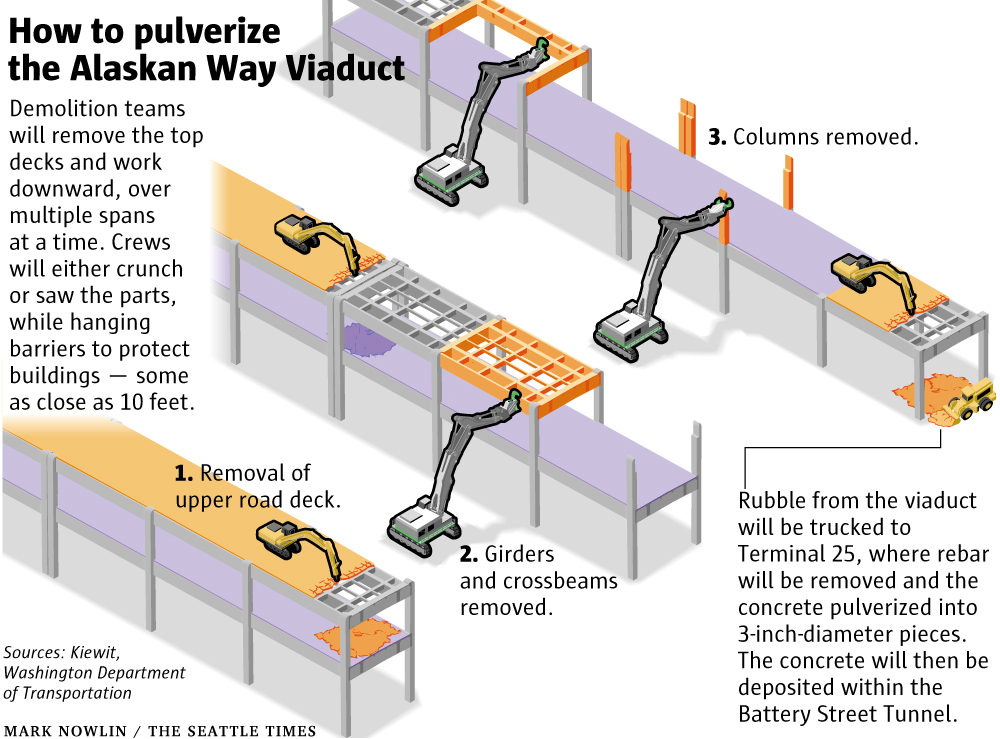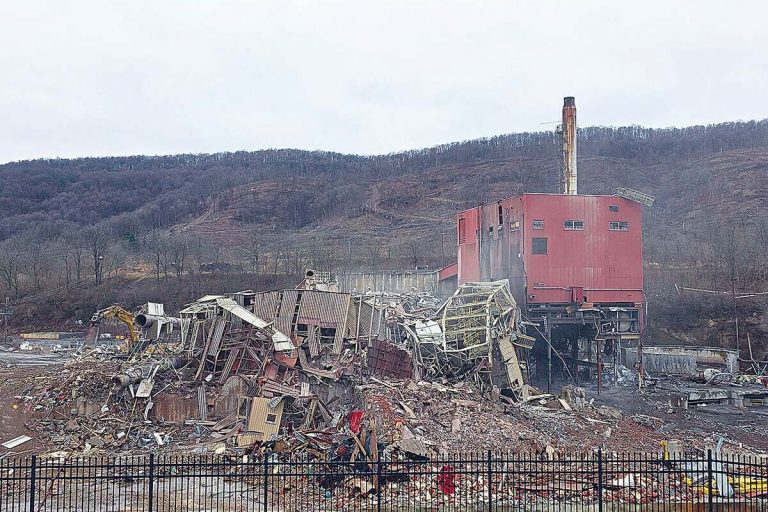
Demolition crews are laying the groundwork to crunch the Alaskan Way Viaduct into little three-inch chunks, starting no later than Friday.
The bulk of the project will be finished by June 1, so that 85-decibel pounding and rubble piles are gone before tourist crowds arrive. The far south decks, alongside diagonal Railroad Avenue South, might remain until July.
The city delayed start of the demolition for three days to keep trucks off snowy streets. Phil Wallace, senior operations manager for contractor Kiewit Infrastructure West, said the removal schedule should hold anyway, and he can add Saturday shifts if needed.
Traffic Lab is a Seattle Times project that digs into the region’s thorny transportation issues, spotlights promising approaches to easing gridlock, and helps readers find the best ways to get around. It is funded with the help of community sponsors Alaska Airlines, CenturyLink, Kemper Development Co., NHL Seattle, PEMCO Mutual Insurance Company and Seattle Children’s hospital. Seattle Times editors and reporters operate independently of our funders and maintain editorial control over Traffic Lab content.
Learn more about Traffic Lab » | Follow us on Twitter »
On Wednesday, workers assembled long-necked concrete-busting machines that can reach the top deck of the 60-foot-high viaduct. Shorter-necked machines will roll on the viaduct decks.
Most Read Local Stories
Chain-link fences were installed, and eviction notices were taped to a half-dozen tents, telling homeless people to leave by Thursday morning. Dirt was poured to protect pavement and prevent chunks of the viaduct from bouncing.
The state has installed three cameras so people can watch as the viaduct comes down.
Sign up for Morning Brief
Delivered bright and early weekday mornings, this email provides a quick overview of top stories and need-to-know news.
Deck-breaking will begin in three places this week: the southbound Columbia Street onramp, so the city can rebuild Columbia as a permanent two-way bus corridor; a segment next to Pike Place Market, to quickly get clear of the downtown railroad tunnel and the Overlook Walk project to be built from the market to Seattle Aquarium; and at the Battery Street Tunnel, where median barriers are already being removed.
By contract, the demolition must move quickly so that no city block is closed for more than 30 consecutive days. Detours and lane closures will constantly fluctuate this spring, as will walking routes around work zones.
Four weeks have passed since thousands of drivers cruised the viaduct Jan. 11, to honk, spin tires or park for a final view before midnight, when the road closed for good. Then, about 120,000 people walked, ran or biked Feb. 2-3 for a public celebration on the condemned 65-year-old structure.
The viaduct was replaced Feb. 4 by the Highway 99 tunnel that empties traffic at South Lake Union and Sodo exits, the biggest part of the state’s $3.3 billion highway rebuild.
ADVERTISING
Ground Zero for demolition is the historic Polson Building at 71 Columbia St., where the employees at Bassetti Architecture can look 15 feet out at an empty southbound onramp.
After eight years of construction and delays for the viaduct’s replacement tunnel, the firm hasn’t scheduled a destruction-viewing party for clients and family yet, “because we weren’t convinced they were even going to do it,” said business manager Christopher Wilton. But at last, the highway is coming down.
“Good to know it’s finally getting done,” said Gerry Leonard, general manager at Fado Irish Pub, the expansive soccer bar at First Avenue and Columbia. “If all goes according to schedule, it will be over for use before St. Patrick’s Day, and before Sounders and Mariners seasons.”
Demolition subcontractor FERMA will start at First Avenue, breaking half the onramp by around Feb. 20 and reaching the mainline by early March, said Kiewit staff. The munching jaws, with blades inside, can flex several times a second, so the concrete continuously crumbles. Water will be sprayed to knock down the dust.
Now that the new Highway 99 tunnel is open to commuters, demolition crews will start tearing down the Alaskan Way Viaduct. (Mark Nowlin / The Seattle Times)
Concrete debris will be taken to Terminal 25 near the West Seattle Bridge, so any remaining rebar can be extracted and big chunks smashed. Trucks and conveyor belts then will deposit the broken concrete as fill in the defunct Battery Street Tunnel.
The Polson, a former warehouse built in 1910, has survived at least two fires. It’s now home to Bassetti, Mahlum and Miller | Hull architecture firms as well as Waterfront Seattle public-development headquarters. During long phases of tunnel construction, the basement parking garage was closed. Lasers and gauges were installed in and near the structure, to detect any ground sinking caused by the drilling machine Bertha.
A fifth-floor meeting room looks directly from Bassetti Architects over the Columbia onramp. Productivity will lapse for a few days, Wilton said, as people gather at the windows to watch the viaduct crumble.
“It’ll be fun to watch. It will be loud. I expect it to go down quickly,” he said. Removal will improve the waterfront, but Wilton wishes a segment were kept for public walking and bicycling, as New York did with the High Line park, he said.
Instead, larger buildings are on the way, which will block many sightlines — including the Polson’s view toward the northwest. For people who can’t afford a view suite, the main benefit of losing the viaduct is elimination of its 80-decibel traffic roar.
As the demolition proceeds, workers will extract viaduct pieces within five to 10 feet of some buildings.
Tight spots include Compass Housing apartments near Yesler Way, so close that a car knocked concrete through a resident’s window in 2006; the 1426 Alaskan Way building being used as a construction office, just north of the former Highway 99 Blues Club; and 66 Bell Street, where the viaduct guardrail was built against the corner of the historic Empire Laundry building.
Where the buildings are close, FERMA will saw viaduct columns and girders so they can be extracted in large pieces using cranes. Mesh barriers will be hung between the viaduct and nearby buildings along many blocks.
Ferry passengers can continue taking the Marion Street footbridge that crosses below the viaduct, probably until May. They’ll then switch to another walkway leading to a temporary steel bridge at Columbia Street that will cross to Colman Dock, said Brian Nielsen, state Highway 99 administrator.
At Top Pot Donuts, whose door opens onto the Marion Street footbridge, morning-shift manager Aislynne McVicker expects a good year. The footbridge will remain accessible from the existing Western Avenue staircases, or from First Avenue.
“We get a lot of regulars, so we’ve not been too concerned,” she said.
Mike Lindblom: 206-515-5631 or ml*******@**********es.com; on Twitter: @MikeLindblom. Staff reporter Mike Lindblom covers transportation for The Seattle Times.




